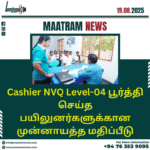டிஜிட்டல் மார்க்கெட்டிங் எப்படி செயல்படுகிறது என உங்களுக்கு தெரியுமா?

இன்றைய காலத்தில் எந்த வியாபாரமாக இருந்தாலும் ஆன்லைன் பக்கம் கவனம் செலுத்தாமல் வெற்றி பெற முடியாது. மக்கள் அனைவரும் நாளொன்றுக்கு குறைந்தது சில மணி நேரங்கள் இணையத்தில் செலவழிப்பதால், அவர்களை சென்றடையும் சிறந்த வழி டிஜிட்டல் மார்க்கெட்டிங் தான்.
டிஜிட்டல் மார்க்கெட்டிங் என்பது வெறும் விளம்பரங்கள் போடுவது மட்டும் அல்ல. அது ஒரு திட்டமிட்ட நடைமுறை. அதில் தயாரிப்புகளை மக்கள் மனதில் அறிமுகப்படுத்துதல், அவர்களின் விருப்பங்களை புரிந்து கொள்ளல். ஈடுபாடு உண்டாக்குதல், இறுதியில் அவர்களை உற்பத்திகளை வாங்கும் நிலைக்கு கொண்டு வருதல் ஆகியவை அடங்கும்.
டிஜிட்டல் மார்க்கெட்டிங்கின் முக்கியத்துவம்
உலகளாவிய சென்றடைவு – நீங்கள் ஒரு சிறிய நகரத்தில் கடை வைத்திருந்தாலும், டிஜிட்டல் மார்க்கெட்டிங்கின் மூலம் உலகம் முழுவதும் உள்ள வாடிக்கையாளர்களை அடையலாம்.
செலவு குறைவு – TV, Radio, Newspaper ad போல் அதிக செலவில்லாமல் குறைந்த முதலீட்டில் பெரிய அளவிலான மக்களை அடையலாம்.
அளவீடு செய்யக்கூடியது – உங்கள் ad-ஐ எத்தனை பேர் பார்த்தார்கள், எத்தனை பேர் click செய்தார்கள், எத்தனை பேர் வாங்கினார்கள் என்பதனை Google Analytics, Meta Business Suite போன்ற கருவிகள் மூலம் உடனுக்குடன் தெரிந்து கொள்ளலாம்.
வாடிக்கையாளர்களுடன் நேரடி தொடர்பு – Social media comments, live chat, email ஆகியவற்றின் மூலம் உடனடி தொடர்பு கொள்ளலாம்.
டிஜிட்டல் மார்க்கெட்டிங்கின் முக்கிய வகைகள்
- உள்ளடக்க (Content) மார்க்கெட்டிங்
உள்ளடக்கம் தான் marketing-ன் backbone.
Blog posts, Case studies, How-to videos, Infographics போன்றவை வாடிக்கையாளர்களின் நம்பிக்கையை ஈர்க்கும்.
HubSpot, Canva, Grammarly போன்ற tools உள்ளடக்கத்தை மேம்படுத்த உதவும்.
உதாரணம்: ஒரு காஃபி பிராண்ட் “How to make perfect cold coffee at home” என்ற YouTube வீடியோ போட்டால், அந்த பிராண்ட் மீது ஆர்வம் அதிகரிக்கும்.
- தேடுபொறி செயல்திறன் மேம்பாடு (SEO)
SEO இல்லாமல் உங்கள் இணையதளம் Google-ல் கிடைப்பது கடினம்.
மூன்று முக்கிய அம்சங்கள்:
On-Page SEO (keywords, meta tags, content quality)
Off-Page SEO (backlinks, social shares)
Technical SEO (site speed, mobile-friendly design)
Ahrefs, SEMrush, Google Search Console போன்ற கருவிகள் SEO-வை ஆய்வு செய்ய உதவும்.
Long-term growthக்காக SEO மிகவும் அவசியம்.
- Pay-Per-Click (PPC)
குறுகிய காலத்தில் traffic வேண்டும் என்றால் இது சிறந்தது.
Google Ads, Facebook Ads, Instagram Ads போன்றவை PPC அடிப்படையில் இயங்கும்.
Retargeting ads மூலம் உங்கள் இணையதளத்தை வந்தும் வாங்காத வாடிக்கையாளர்களுக்கு மீண்டும் ad காட்டலாம்.
கவனிக்க வேண்டியது: PPC-க்கு budget இல்லாமல் நீண்டகாலம் நடத்த முடியாது.
- சமூக ஊடக மார்க்கெட்டிங்
மக்கள் அதிக நேரம் செலவிடும் இடம் → Facebook, Instagram, TikTok, YouTube.
Organic reach (free posts) + Paid ads இரண்டும் சேர்த்து strategy தேவை.
Influencer marketing கூட social media marketing-ன் ஓர் அங்கம்.
உதாரணம்: Cosmetic brands Instagram-ல் beauty influencers-ஐ வைத்து தங்கள் product-ஐ விளம்பரம் செய்கின்றன.
- மின்னஞ்சல் மார்க்கெட்டிங்
மிகப் பழைய digital marketing technique என்றாலும் இன்னும் மிகவும் சக்திவாய்ந்தது.
Personalization (வாடிக்கையாளரின் பெயரை பயன்படுத்தி) செய்வது open rate அதிகரிக்கும்.
Mailchimp, ConvertKit, SendinBlue போன்ற கருவிகள் பிரபலமானவை.
“Cart Abandonment Email” என்பது மிகவும் பயனுள்ளது → வாடிக்கையாளர் checkout-ல் நிறுத்திவிட்டால், அவருக்கு reminder email அனுப்பப்படும்.
- அஃபிலியேட் (Affiliate) மார்க்கெட்டிங்
Affiliate marketers உங்கள் தயாரிப்பை அவர்களின் platform-ல் promote செய்வார்கள்.
Sale நடந்தால் மட்டுமே கமிஷன் கொடுக்க வேண்டும்.
Amazon Affiliate Program உலகில் மிகவும் பிரபலமானது.
சிறிய நிறுவனங்களும் bloggers-ஐ வைத்து affiliate marketing செய்யலாம்.
டிஜிட்டல் மார்க்கெட்டிங் செயல்முறை
Awareness (அறிமுகம்) – Blog, SEO, Ads மூலம் மக்கள் உங்களை அறிய ஆரம்பிக்கிறார்கள்.
Interest (ஆர்வம்) – அவர்களுக்கு பயன்படும் content, ebooks, webinars மூலம் அவர்களை engage செய்வது.
Consideration (சிந்தனை) – Email campaigns, case studies, reviews மூலம் நம்பிக்கை உருவாக்குதல்.
Decision (முடிவு) – Offers, free trials, testimonials மூலம் அவர்களை வாங்கும் நிலைக்கு கொண்டுவருதல்.
Loyalty (நம்பிக்கை) – Customer support, rewards, personalized emails மூலம் நீண்டகால உறவை வளர்த்தல்.
சவால்கள் (Challenges)
மிகுந்த போட்டி (Digital space-ல் அனைவரும் இருக்கிறார்கள்).
எப்போதும் மாறிக்கொண்டிருக்கும் algorithms (Google updates, Social media rules).
Data privacy laws (GDPR, Cookies policy) பின்பற்ற வேண்டியது அவசியம்.
தொடர்ந்து content உருவாக்க வேண்டிய அவசியம்.
எதிர்காலம் (Future of Digital Marketing)
AI & Automation – ChatGPT, Jasper போன்ற AI tools content உருவாக்கத்திலும், customer support-லுமே அதிகம் பயன்படும்.
Voice Search – Alexa, Google Assistant மூலம் மக்கள் தேடல் செய்வது அதிகரித்து வருகிறது. அதற்கேற்ற SEO தேவை.
Video & Short-form Content – TikTok, Reels, YouTube Shorts → customer attention பிடிக்கும் முக்கிய வடிவம்.
Data-driven Marketing – Analytics மற்றும் personalization முக்கிய பங்கு வகிக்கும்.
மேலதிக தகவல்களுக்கு மாற்றம் செய்திகள் இணையத்தளத்தினுள் பிரவேசியுங்கள்.
மேலதிக தகவல்களை உடனுக்குடன் பெற்றுக்கொள்ள மாற்றம் செய்திகள் முகநூல் பக்கத்தை பின்தொடரவும்.
Understanding Digital Marketing
In today’s world, no business can succeed without focusing on its online presence. Since people spend several hours daily on the internet, the best way to reach them is through digital marketing.
Digital marketing is not just about running ads; it’s a well-planned strategy. It involves introducing your products or services to people, understanding their interests, engaging with them, and eventually guiding them toward making a purchase.
Why Digital Marketing Matters
- Global Reach – Even if you run a small store in a small town, digital marketing allows you to reach customers across the world.
- Cost-Effective – Compared to TV, radio, or print advertising, digital marketing is cheaper and more accessible.
- Measurable Results – With tools like Google Analytics and Meta Business Suite, you can track who viewed your ads, who clicked, and who made a purchase.
- Direct Interaction – Through social media comments, live chat, or email, businesses can directly communicate with customers.
Key Types of Digital Marketing
1. Content Marketing
- Content is the backbone of digital marketing.
- Blog posts, case studies, how-to videos, infographics help build trust with customers.
- Tools like HubSpot, Canva, Grammarly are widely used for content creation.
- Example: A coffee brand making a video titled “How to Make the Perfect Cold Coffee at Home” will naturally attract customers to their products.
2. Search Engine Optimization (SEO)
- Without SEO, your website will hardly appear on Google searches.
- Three core aspects:
- On-Page SEO (keywords, meta tags, content quality)
- Off-Page SEO (backlinks, social shares)
- Technical SEO (site speed, mobile-friendliness)
- Tools like Ahrefs, SEMrush, Google Search Console help improve SEO.
- SEO is essential for long-term growth and organic traffic.
3. Pay-Per-Click (PPC)
- Ideal for businesses that want quick results.
- Platforms: Google Ads, Facebook Ads, Instagram Ads.
- Retargeting ads show reminders to users who visited your site but didn’t purchase.
- Note: PPC works only with continuous budget allocation; once you stop paying, traffic declines.
4. Social Media Marketing
- People spend most of their time on platforms like Facebook, Instagram, TikTok, and YouTube.
- A good mix of organic reach (free posts) and paid ads is needed.
- Influencer marketing is also a key part of social media strategy.
- Example: Cosmetic brands often collaborate with beauty influencers on Instagram to promote their products.
5. Email Marketing
- One of the oldest yet most powerful digital marketing methods.
- Personalized emails (using the customer’s name) boost open rates.
- Popular tools: Mailchimp, ConvertKit, SendinBlue.
- Cart Abandonment Emails are highly effective — if a customer leaves items in the cart, an email reminder helps convert them.
6. Affiliate Marketing
- Third-party affiliates promote your products on their websites, blogs, or social media.
- They earn a commission only when a sale happens.
- Amazon Affiliate Program is the most popular example worldwide.
- Even small businesses can collaborate with bloggers or micro-influencers to grow their reach.
The Digital Marketing Process
- Awareness – People discover your brand through blogs, SEO, or ads.
- Interest – Engaging content like ebooks, guides, or webinars builds curiosity.
- Consideration – Email campaigns, case studies, and reviews create trust.
- Decision – Discounts, free trials, or testimonials help customers make the final purchase.
- Loyalty – Good support, rewards, and personalized emails encourage long-term relationships.
Challenges in Digital Marketing
- High competition – Every business is online, so standing out is tough.
- Changing algorithms – Google updates and social media policies keep shifting.
- Data privacy – Compliance with GDPR, cookie policies, and privacy laws is crucial.
- Consistent content creation – Regular, quality content is a must to stay relevant.
The Future of Digital Marketing
- AI & Automation – Tools like ChatGPT and Jasper are revolutionizing content creation and customer support.
- Voice Search – With Alexa and Google Assistant, voice search optimization is becoming essential.
- Video & Short-Form Content – TikTok, Instagram Reels, and YouTube Shorts are dominating attention spans.
- Data-Driven Marketing – Analytics and personalization will drive decision-making.
Conclusion
Digital marketing is not a “one-time advertising method.” It’s an ongoing journey that blends content, SEO, social media, email, and ads into one holistic strategy. Success comes when businesses truly understand their customers and provide real value.
From startups to global corporations, digital marketing is the key to growth and success in today’s competitive world.



